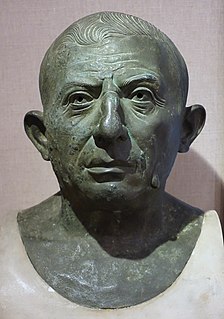Related Research Articles

The 2nd century BC started the first day of 200 BC and ended the last day of 101 BC. It is considered part of the Classical era, although depending on the region being studied, other terms may be more suitable. It is also considered to be the end of the Axial Age. In the context of the Eastern Mediterranean, it is referred to as the Hellenistic period.
This article concerns the period 79 BC – 70 BC.
This article concerns the period 129 BC – 120 BC.
This article concerns the period 149 BC – 140 BC.
This article concerns the period 159 BC – 150 BC.

Year 133 BC was a year of the pre-Julian Roman calendar. At the time it was known as the Year of the Consulship of Scaevola and Frugi and the Second Year of Yuanguang. The denomination 133 BC for this year has been used since the early medieval period, when the Anno Domini calendar era became the prevalent method in Europe for naming years.
Tiberius Sempronius Gracchus was a populist Roman politician best known for his agrarian reform law entailing the transfer of land from the Roman state and wealthy landowners to poorer citizens. Against stiff opposition in the aristocratic Senate, this legislation was carried through during his term as tribune of the plebs in 133 BC. Fears of Tiberius's populist programme, as well as his uncompromising behavior, led to him being killed, along with many supporters, in a riot instigated by his senatorial enemies. A decade later his younger brother Gaius attempted similar legislation and suffered a similar fate.

Publius Cornelius Scipio Africanus Aemilianus, primarily known as Scipio Aemilianus, was a Roman general and statesman noted for his military exploits in the Third Punic War against Carthage and during the Numantine War in Spain. He oversaw the final defeat and destruction of the city of Carthage. He was a prominent patron of writers and philosophers, the most famous of whom was the Greek historian Polybius. In politics, he opposed the populist reform program of his murdered brother-in-law, Tiberius Gracchus.

Eumenes III was a pretender to the throne of Pergamon. He led the revolt against the Pergamene regime and found success early on, seizing various cities near the coast of Anatolia, including the island of Samos, and killing the Roman consul Publius Licinius Crassus Dives Mucianus. However, the revolt was eventually quelled by the Roman Republic in 129 BC when it dispatched the experienced Marcus Perperna to the region.
Quintus Caecilius Metellus Macedonicus was a statesman and general of the Roman Republic during the second century BC. He was praetor in 148 BC, consul in 143 BC, the Proconsul of Hispania Citerior in 142 BC and censor in 131 BC. He got his agnomen, Macedonicus, for his victory over the Macedonians in the Fourth Macedonian War.
Publius Licinius Crassus Dives Mucianus was the natural son of Publius Mucius Scaevola and Licinia, and brother of Publius Mucius Scaevola. He was adopted at an unknown date by Publius Licinius Crassus, his mother's brother, or by a son of the consul of 205 BC, Publius Licinus Crassus Dives.
Publius Mucius Scaevola was a prominent Roman politician and jurist who was consul in 133 BC. In his earlier political career he was tribune of the plebs in 141 BC and praetor in 136 BC. He also held the position of Pontifex Maximus for sixteen years after his consulship and died around 115 BC.

The Numantine War was the last conflict of the Celtiberian Wars fought by the Romans to subdue those people along the Ebro. It was a twenty-year conflict between the Celtiberian tribes of Hispania Citerior and the Roman government. It began in 154 BC as a revolt of the Celtiberians of Numantia on the Douro. The first phase of the war ended in 151, but in 143, war flared up again with a new insurrection in Numantia.
Gaius Laelius C.f. Sapiens, was a Roman statesman, best known for his friendship with the Roman general and statesman Scipio Aemilianus. He was consul of 140 BC, elected with the help of his friend, by then censor, after failing to be elected in 141 BC. Gaius Laelius Sapiens was the son and heir of the Punic War general Gaius Laelius, himself consul in 190 BC. This Laelius had been former second-in-command and long-time friend, since childhood, of the Roman general and statesman Scipio Africanus. The younger Laelius was apparently born around 188 BC, after his father had become consul but had failed to win command of the campaign against Antiochus III the Great of Syria, which would have made him a rich man. His mother's name is unknown.
Gaius Caecilius Metellus Caprarius was a consul of the Roman Republic in 113 BC with Gnaeus Papirius Carbo. He served under Scipio Aemilianus in Numantia around 133 BC. He was praetor in 117 BC. His proconsulship in Thrace in 112–111 BC earned him a triumph. He was censor in 102 BC with his cousin, Quintus Caecilius Metellus Numidicus.
Quintus Caecilius Metellus Creticus was a politically active member of the Roman upper class. He was praetor in 74 BC and pontifex from 73 BC until his death. He was consul in 69 BC along with Quintus Hortensius Hortalus.

The gens Caecilia was a plebeian family at ancient Rome. Members of this gens are mentioned in history as early as the fifth century BC, but the first of the Caecilii who obtained the consulship was Lucius Caecilius Metellus Denter, in 284 BC. The Caecilii Metelli were one of the most powerful families of the late Republic, from the decades before the First Punic War down to the time of Augustus.
This section of the timeline of Hispania concerns Spanish and Portuguese history events from the Carthaginian conquests to before the barbarian invasions.